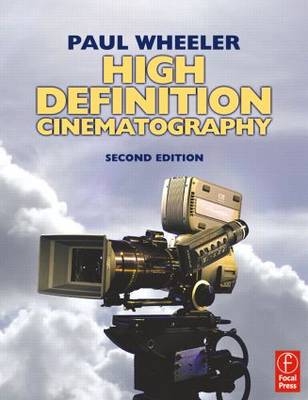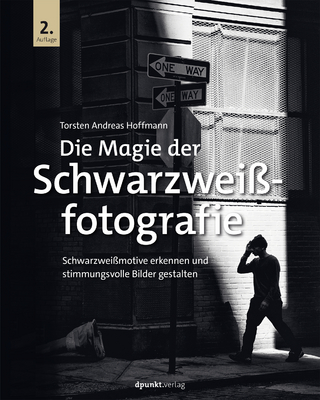
High Definition Cinematography
Focal Press (Verlag)
978-0-240-52036-0 (ISBN)
- Titel erscheint in neuer Auflage
- Artikel merken
High definition is here to stay.
HD changes the whole shooting and editing process in film and television production and this book is to satisfy your hunger for information. Whether you are a cinematographer, producer, or working in film/TV production, High Definition Cinematography, 2nd edition will demystitify the new technology, help you select the right cameras and equipment, and explain how high definition affects the shooting process and budgets. Filled with practical advice for tackling everyday decisions and choices, this is a necessity for you if you are using or considering using high definition technology.
Paul Wheeler BSC FBKS was trained at the BBC rising to become a Senior Drama Film Cameraman. Paul Shot one of the first BBC Drama Series to be photographed using the then new Digi Beta cameras, by which time he was freelance. He is a renowned cinematographer/director of photography and trainer, he has been Head of Cinematography at National Film & Television School and still runs courses on Digital Cinematography there. He has also been Head of Cinematography on the Royal College of Arts MA course. Paul was invited to become an associate of Panavision in order to help them introduce the Panavised version of Sony's HDW 900f camera which meant he joined the HD movement 3 days before the first Panavision camera arrived in Europe. Despite all this he is still very much a working cinematographer. He has been twice nominated by BAFTA for a Best Cinematography award and also twice been the winner of the INDIE award for Best Digital Cinematography. His previous books, "Practical Cinematography and "Digital cinematography, are both published by the Focal Press.
Part one:High Definition - a quick overview; 1-What do we mean by High Definition (HD)?; The knowledge base; What does it mean to the producer - saving money!; What does it mean to the Director?; What does it mean to the Director of Photography?; What does it mean to the other crafts?; Editing and Post Production; Part two-Production Decisions; 2-Which formats to shoot on?; Progressive or Interlace?; How many pixels do you need; Recording formats; HDV - can you get away with it?; 3-Picture Quality; What does HD look like?; HD images compared with 35mm; Anamorphic 35mm; Comparisons with Super 16mm; Comparison with Digi Beta; 4-Display quality; HD Shown on a television; HD Written to film and projected mechanically; HD Shown on a state of the art digital projector; Digital projectors; The Barco D-Cine DP 40 Premier; The Barco SLM R8; 5-Delivery requirements; For delivery on film; Multi format delivery requirements; For HD Projection; Encryption; Broadcast delivery; Convertibility; Picture; Sound; Time code; 6-Sales potential; Multiple standard sales; Multiple venue sales; Additional sales to HD users; Future proofing; 7-Cost implications; Savings; Origination costs; Stock Savings; Insurance savings; Savings in print costs; Shooting for anamorphic release; Added costs; Camera Kit rental; Writing out to film; A cost comparison example - "Oklahoma"; Stock and processing savings; Camera rental; Additional costs; Overall savings; Competitive pricing; 8-Crewing; Should the DP operate?; Do you need a focus puller?; Do you need a loader?; Naming the camera assistants; Do you need a clapper board?; Do you need a dolly grip?; Sound; Electricians; 9-Different shooting requirements; General considerations; Shooting in the US; Theatrical productions; US Prime Time television productions; US Commercials; Potential Savings; Other US productions; What frame rate to chose; European television; Potential cost savings; European productions; European feature films; European television; Performance shows; "Oklahoma"; "The Merchant of Venice"; Part three: The Technology; 10-Digital imaging; The history of digits; Digital tonal range; Linear and logarithmic sampling; Image resolution, why so many pixels?; Required resolution for HD; Data Quantity; 11-Scanning the Image; A little of the history of television; Interlace Scanning; Progressive scanning; Printing out to Film; 12-Line Standards and Definition; Line Summation; Apparent Picture Quality; 1080 versus 720; Conclusions; 13-Three Chip Technology; Additive Colour Imagery; The Three Chip Camera's Beam Splitter; The Image Sensors; The Sensor Chip;
14-Single chip Technology; What's available?; CCD sensors; CMOS sensors; CCDs Versus CMOS chips; Here is a check List; Colour filtering in single sensors; Bayer pattern filtering; Sequential filtering; The effect of increasing the pixel count; 15-The Video Tape Recorder (VTR); The HDCAM Format; Helical Scan Recording; Mechanical Considerations; The Drum Lacing Mechanism; Operational Considerations; A Jammed Mechanism; Part Four-HD Cinematography; 16-Lighting and exposing for HD; Equivalent ASA speed; Tonal range; Lighting ratios; Lighting to a monitor; Highlights and shadows; Exposure; Using a monitor; Using an exposure meter; Auto Exposure; Exposing using a waveform monitor; 17-Setting the Colour balance; White balance; What is white balance?; ND Filters; A warning!; Setting the white balance using a white card; Setting the white balance using a coloured card; Setting the white balance under fluorescent lighting; The outer filter wheel on a Sony HDW Camera; Black balance; 18-Lenses; How to chose a lens; Resolution; Contrast; Perceived sharpness with regard to contrast; Colour rendition; Overall colour bias; Colour fringing; What is fringing?; Breathing; Setting the back focus; Setting the back focus - Zoom lenses; Setting the back focus - Prime lenses; Focusing a lens using back focus charts - Beware!; Back focusing using the oval rings chart; Comparative focal lengths; Depth of field; Calculating depth of field; Neutral Density filters; Limiting apertures; Filtration; Colour correction; Diffusion; 19-Monitors and cabling; What kind of Monitors are Available?; Cathode Ray Tube Monitors; Liquid Crystal Display Monitors; Plasma Screens; Lining up your Monitor; An SMPTE Line Up; Lining up using EBU Bars; Using an Exposure Meter; Cabling your Monitor; Single Coaxial Cables; Triple Coaxial Cables; Termination
Serial Monitors; Best Practice; 20-Playback; Don't use the camera!; Using the Sony HDW F500 VTR or equivalent for playback; Using DV for playback; Using two DV recorders; Down converters from Sony HDV cameras; The Evertz down converter; The Miranda down converter; Sound delay lines; Playback packages; 21-Shipping; It's not ENG!; Shipping lenses; Transit cases; Camera set-up when shipping; Size and weight; Batteries; 22Multi camera shoots; Synchronisation; Time code on location; Lock It Boxes; Script Boy; Time code in a studio; Genlock; Menu set ups; The Sony RMB 150; Using memory sticks; Matching lenses; 23-Hazardous conditions; Re-setting the trips; Water; Heat; Cold; Dust; Gamma rays; 24-Camera supports; Fluid heads; Geared heads; Remote heads; Under water; In the air; Motion control rigs; 25-How HD affects other crafts; Art and Design; Costume; Make up and Hair; Sound; Script supervision and continuity; The second assistant cameraperson or ex-clapper boy;
26-Troubleshooting; Stating the Obvious; Problems and Solutions; No image on Monitor; Monitor shows colouration; No image in viewfinder; No image through down converter; Camera will not power up; Camera will not record; Monitor too bright; Monitor is green; Monitor shows bright single pixel; Image vignettes; Image blurred when panning; Image looks soft; Footage marks on lens wrong; Camera will not accept external time code; No signal on camera VU meter; Lens Ret not working; White balance not working; Audio not in sync when using down converter; Part five: Examples of shoots; 27-Some pictures that made it to HD - and why; "The Children of Dune"; Rushes requirements; An extended playback facility; The equipment list; "Birthdays"; The Studio Shoot; The location shoot; Exterior tracking shots; Interior lighting; Adding gain; Editing "Birthdays"; Viewings; Part six:Post Productionl; 28Post production - an overview; Generations; How the choice of edit suite effects the generation game; The route to a film copy; Non photographic distribution; An international standard
Where might it be shown; Time code; Considerations;
29-The Sony HDW F500 Desktop VTR; VTR's in general; An overview of the HDW F500; Editing and Playback; Simultaneous playback; Slow motion replay; High speed picture search; Digital jog sound; Vertical interval time-code (VITC) read / write; The control panel; Remote control; In / out capacity; Optional plug in boards; Cassettes; Changing the frame rate; Available frame rates; Power supplies; Part seven: Cameras; 30-Cameras in general; My choice of cameras; My disclaimer!; 31-The Arriflex D-20; The camera; The Camera's chip; Interface; Lenses; Recorders; 32-The Dalsa Origin; The camera; The look through; The Sensor; Interfaces; Conclusions on the Dalsa Origin; Currently available recorders; The Codex Media Recorder; The Touch Screen; Monitoring via the Codex; Conclusions on the Codex; 3-The Panavision Genesis; The Camera; Menus; White balance; The camera sensor; Formats, Outputs and Interface; Viewing logarithmic images; 34-The Panavision HDW F900 and its system; Introduction; External modifications;The top handle; The viewfinder support; The viewfinder; the camera front plate and lens mount; The camera base plate; The voltage distribution box; The internal filter; Electronic modifications; the internal filter; Electronic definition enhancement; 35-The Sony HDW 750P and the 730 HD cameras; frame rates; The camera body; Add -in boards etc.; Image control via the menus; Multi matrix; Auto tracing white balance; Colour temperature control; Selectable gamma curves; RGB gamma balance; Variable black; gamma balance; Black stretch; Adaptive highlight control (Auto knee mode); Knee saturation function;
The triple skin tone detail control; Level depend detail; Meta-data handling; The Sony Tele-File system; The optional HD SDI adapter; 36-The Sony HDW F900R; The Camera; The Chips; The Processor; Additional facilities; Menus; Overall impressions; 37-The Thomson Viper HD camera; An overview; The camera body; Outputs from the camera; Recording a FilmStream signal; The Directors friend; The Beam Splitter; The Vipers CCD array; The mechanical shutter; Frame rates; Resolution; The cameras processor configuration; The camera back; The arguments for a logarithmic format; Lenses for the Viper; Monitors for the Viper; Camera accessories; Shipping the Viper; Part eight; Camera menus; 38-Menus in general; 39-The Sony HDW F900 menus
| Erscheint lt. Verlag | 27.3.2007 |
|---|---|
| Verlagsort | Oxford |
| Sprache | englisch |
| Maße | 189 x 246 mm |
| Themenwelt | Kunst / Musik / Theater ► Fotokunst |
| Sachbuch/Ratgeber ► Freizeit / Hobby ► Fotografieren / Filmen | |
| ISBN-10 | 0-240-52036-X / 024052036X |
| ISBN-13 | 978-0-240-52036-0 / 9780240520360 |
| Zustand | Neuware |
| Informationen gemäß Produktsicherheitsverordnung (GPSR) | |
| Haben Sie eine Frage zum Produkt? |
aus dem Bereich



